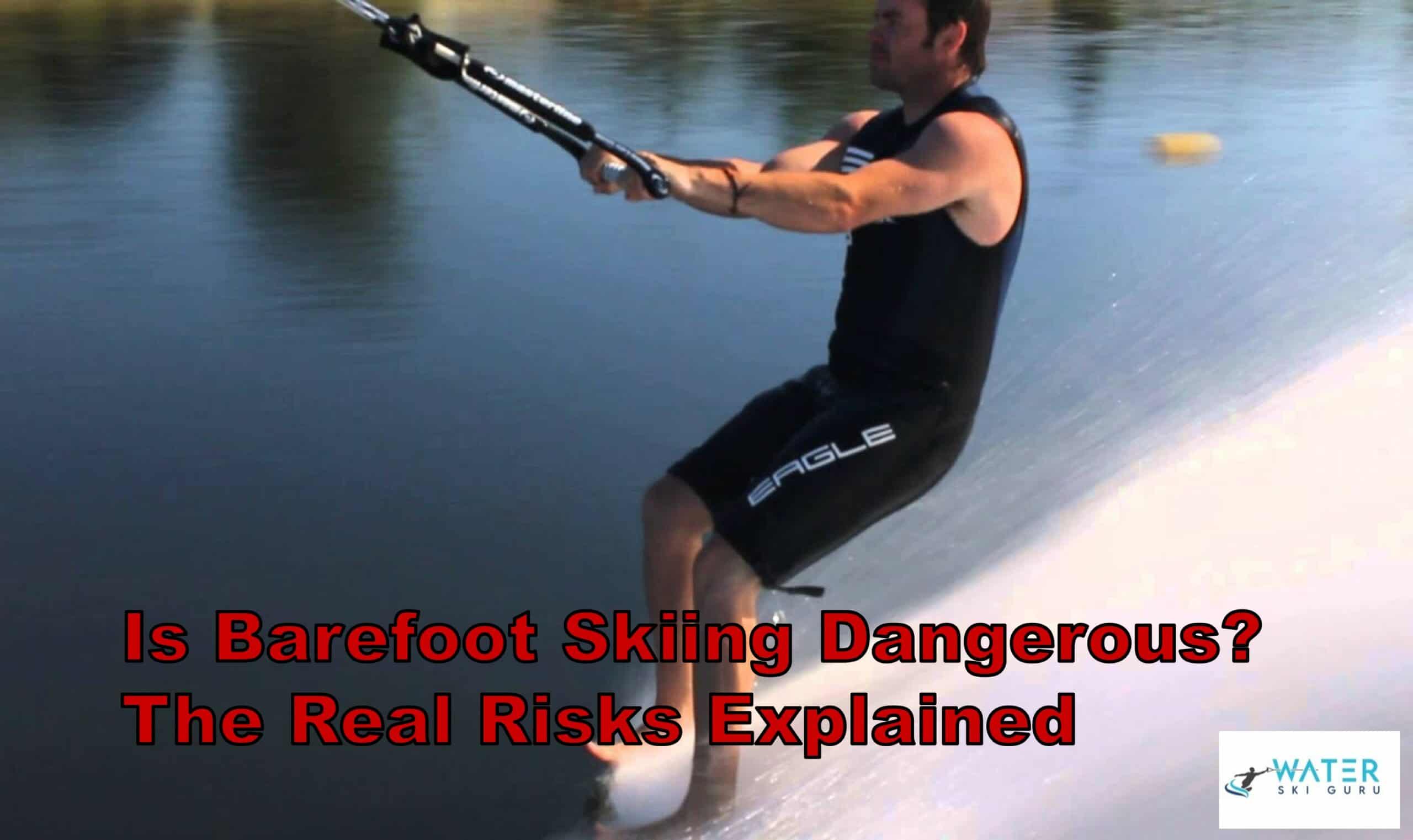Barefoot skiing is now a well-known sport; you don’t use skis during barefooting, and there is no denying that it looks fun and intriguing. However, having your bare feet directly in contact with water while traveling at high speed might have some risks.
So, is barefoot skiing dangerous? Barefoot skiing is not dangerous, but it’s riskier than regular skiing. Your chances of getting injured are higher because your feet will have nothing to protect them from floating objects and other items. Barefoot skiing is usually done at higher speeds than regular skiing which creates a greater risk of injury if you fall.
Keep reading to learn more about the dangers of barefoot skiing such as how fast barefoot skiers go, the rules of barefoot skiing competitions and the required gear, and the real risks of barefoot skiing and how to avoid them.
Is Barefoot Skiing Dangerous?
Barefoot skiing is like most sports – it’s not totally safe, but it’s not life-threatening either. It can be enjoyable if you know what you are doing.
Barefoot skiing, or barefooting, is about the surface tension of the water. It is similar to skipping a rock on water; the stone will keep bouncing on the water till it finally falls deep into the water.
You start by wrapping your feet on the top of the rope, then the boat moves at a speed of around 40 mph and accelerates to 70km. By then, you should go to the surface and start to skim while lying flat on your back.
When you are finally ready and feel comfortable, you can take your feet off the rope and place them on the water. Then, little by little, start applying pressure with your feet on the water.
Sounds easy and fun, right? Well, it is, but if you are a beginner, no matter how enchanting and peaceful the water looks at this high speed, it will feel like your heels are on fire or as if someone placed a hot knife on them. You can even get bruises if the water is a bit rough.
Okay, does the same thing apply to experienced skiers? I mean, it’s the same water and the same speed. Why should it be any different? Well, they do sense the same feeling while barefooting, but they have multiple distractions and many other things to focus on while skiing that helps them take off the pain out of their mind.
How Fast Do Barefoot Skiers Go?
Barefoot skiers’ speed can vary; their minimum speed is 25 mph (40 km), and the average speed ranges around 35-50mph.
Also, it depends on whether it’s by boat or helicopter. The highest speed of barefoot skiers by boat is 135mph/218km and by helicopter is 153mph/246km.
The Real Risks of Barefoot Skiing
The real risks of barefoot skiing usually happen when you fall from the jet ski because falling while traveling at high speed can be pretty painful.
Some common injuries result from falling, such as damage to cartilage and problems with the anterior cruciate ligament and medial collateral ligament. Each one of these accidents will take a long time till you can water ski again.
How to Avoid the Risks of Barefoot Skiing?
There are some things you need to focus on while barefoot skiing to avoid some of the risks that can happen.
- You should never dip your toes into the water; only use your heels (you will faceplant into the water if you dip your toes)
- Only ski on water that’s somewhat choppy and avoid still water; it will make barefoot skiing more painful.
- Pay attention to your pose in the water while skiing, and don’t focus on how your feet feel to avoid falling.
Learn more about barefoot skiing.
Barefoot Skiing Competitions Explained
The barefoot skiing competition consists of three events slalom, tricks, and jump; they are comparable to the events of traditional water skiing.
Each team can score from either round. The skiers will ski the first round in order of the ranking list and the second round in order of their first-round scores.
The second round is the final round; if you didn’t participate in the first round, you would not ski in the second round.
The number of skiers in the competition should be at least 3. If fewer than 3 people enter the competition, they will compete with another lower age group. Also, each and every one of the skiers must be approved by their federation to enter the competition.
The LOC will provide the skiers with accommodation and meals each day they are staying for the competition, plus they will pick them up from the airport.
The competition needs preparation and heavy practice; you must practice behind a boat and record how long it takes you to do it and return.
If you want to participate, you must be 17 at midnight on December 31st of the year of the championship or under 35 at midnight on December 31st of the same year.
Now, let’s explain each event in more detail:
Slalom
In the slalom event, the points are rewarded for the full crossing; you should cross the outside of the first wake wave and then cross to the outside of the second one.
You can do it however you want, with both feet or one foot, backward or forward. However, the more difficult your method is, the more the value of your points will increase.
You must clear the wakes before you return; the world record is by Keith St. Onge; he did it in only 20.6.
Tricks
The tricks event is 2 runs, just like the slalom, and you are given 15 seconds so you can perform as many tricks as you can, and the judges will give the scores.
Jump
Barefoot jumping has some requirements; for example, the jumping distance conditions to qualify you as a barefoot skier is 50 feet for men and 35 feet for women.
In the competition, the takeoff edge of the ramp is about 18 inches above the water line, and you will step off of your ski previous to getting to the step-off buoy, and you should hold your position on the ramp.
You only have three attempts; eventually, the person with the farthest jump is the winner.
What Safety Gear is Required for Barefoot Skiing?
The required gear for barefoot skiing includes:
- Barefoot suit
- Helmet
- Rope and handle
- A bar
- High tower
- Life jacket
- Boat
1 – Barefoot suit
You need a barefoot suit, especially if you are a beginner, the suit will make it easier for you to ski, and it also minimizes the possibility of any injury.
If you are wearing a barefoot suit, you won’t need a life jacket because it is sewn in, so if you can’t swim, it will be an ideal option for you.
2 – Helmet
The helmet will protect you from any sudden incidents because barefoot skiing is usually at high speeds and concussions are frequent in that case.
3 – Ski rope and handle
One of the essential things you will need is a rope and a handle; the ropes of skiing, in general, are made of low-stretch material, and the rope should contain floating handles.
4 – Bar
You need the bar for practice and learning new tricks.
High tower
The high tower can make skiing less tiring for you, plus it reduces the drag. You can find them on barefoot boats.
5 – Life jacket
If you don’t have a suit, you will need a life jacket because even if you are a fantastic swimmer, some cities have rules and laws that you can’t ski without a life jacket.
6 – Boat
Certainly, you need a boat so you can go barefoot skiing on water; the boat must be capable of reaching speeds more than 37 mph.
If you liked this article and found it useful, you can share it with your friends and family, and if you have any questions, please do not hesitate to contact us.
FAQs
How hard is barefoot skiing?
Barefoot skiing can be one of the fiercest water sports because you travel at high speed on your bare feet, the average speed of skiing is around 40 mph, and it can make you tremble and fall off; however, it is also so much fun and feels freeing and liberating.
How fast do you need to go to barefoot ski?
The speed of barefoot skiing is usually around 30-45 mph, and it’s higher than the speed of regular water skiing, which is generally around 20 to 35 mph. This speed can intimidate and excite you; however, if it’s your first-time water skiing, it’s better if you don’t go barefoot.
Can you get hurt waterskiing?
You can get hurt waterskiing; the injuries of waterskiing are usually just sprains, and the most that can happen is that you may get bruised; however, most of the injuries happen if you fall from your jet ski, but the injuries are often not severe.

